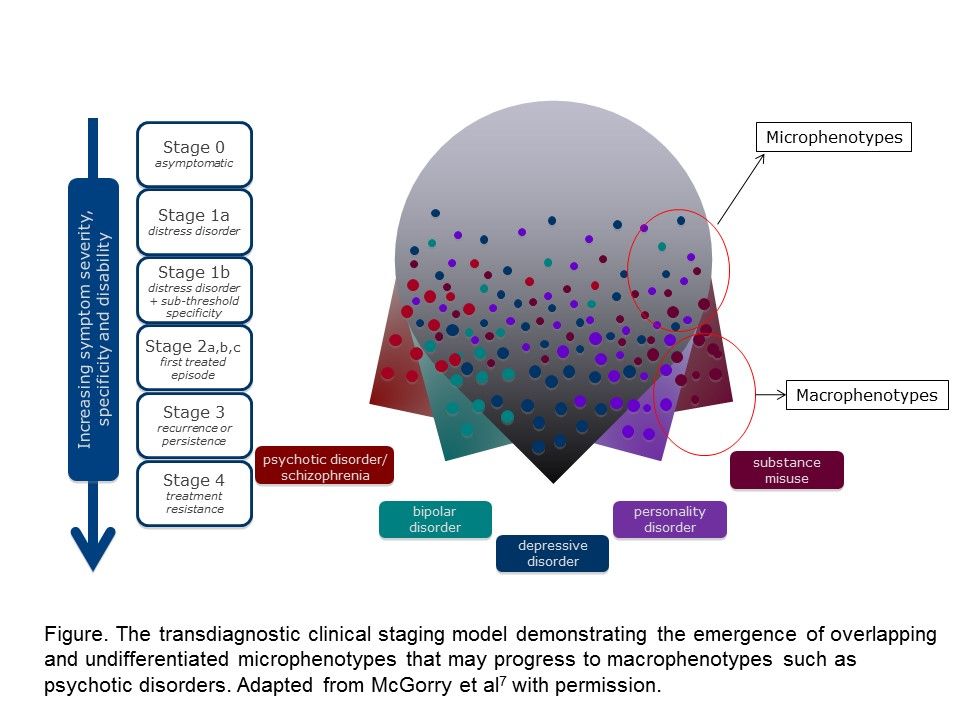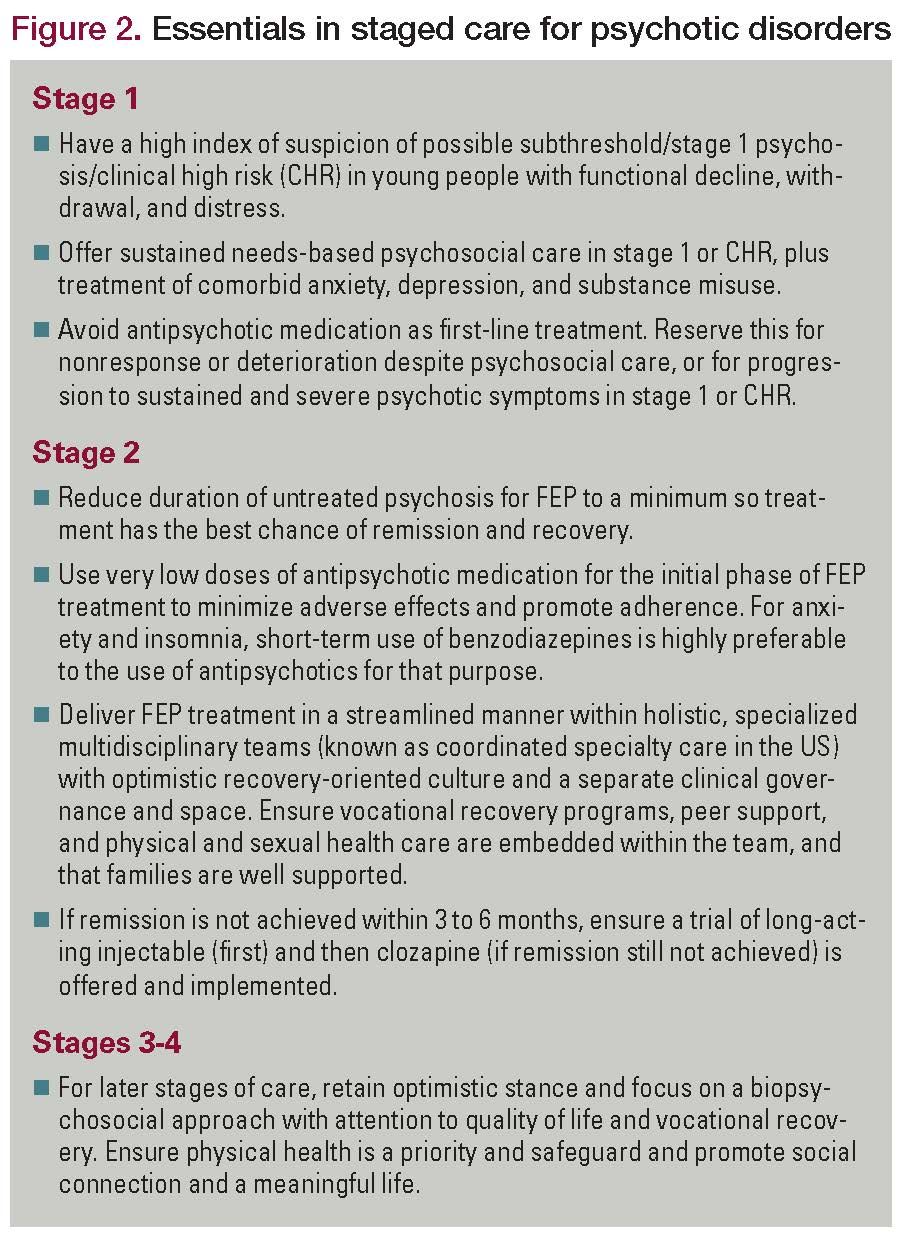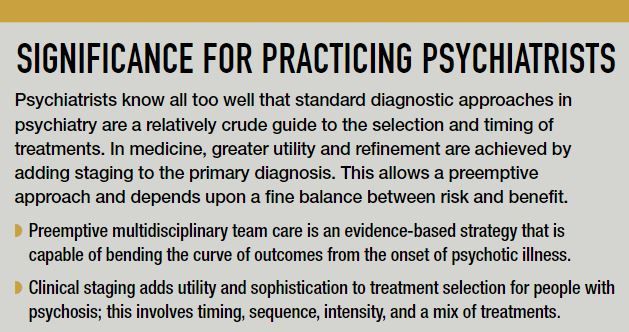Publication
Article
Psychiatric Times
Stage-Specific Treatment of Psychotic Disorders
Author(s):
Psychotic disorders are potentially serious and enduring and have been seriously neglected in health systems worldwide. The good news is that better medium-term outcomes are now achievable.
SPECIAL REPORT: SCHIZOPHRENIA & PSYCHOSIS
Psychotic disorders are potentially serious and enduring, frequently leading to substantial disability and premature death from suicide or comorbid medical illness. These disorders have been seriously neglected in health systems worldwide, even in high-income countries, despite the availability of a range of effective therapeutic interventions and models of care.1 The good news is that better medium-term outcomes are now achievable through early diagnosis and comprehensive early-intervention models of care. Moreover, these outcomes can be sustained, if backed up with high-quality ongoing care to maintain and build on a platform of recovery.2,3 The challenge is to make this evidence-based and cost-effective approach the new standard of care in the US and globally.
Psychosis is best considered as a range of experiences or symptoms that can develop through the intensification of normal beliefs and perceptions to form delusions or hallucinations, or the acquisition of new and abnormal perceptual experiences or delusional ideas. These constitute what are termed the positive symptoms of psychosis; however, there are other dimensions or syndromes associated with psychotic disorders, notably negative symptoms and mood disturbance.
Psychosis may begin with “orphan” or isolated experiences, but more commonly emerges in the context of fluctuating anxiety and depression, subtle subjective and behavioral changes, and subthreshold warning signs. This pattern, which has been carefully operationalized, represents an earlier, less specific stage—even a pluripotential stage––of illness that already justifies a need for care and attracts additional comorbid syndromes and functional impairment (stage 1).4
Once positive psychotic symptoms reach full threshold and are sustained, we can say that the stage of first-episode psychosis (FEP) is now present (stage 2), even if this typically occurs more gradually and dimensionally than is implied by the term, which is to a large extent an artefact of treatment systems. People are allowed to deteriorate to such an extent that a crisis is needed before entry to treatment can be achieved. FEP is a heterogeneous umbrella term comprising a range of DSM/International Classification of Diseases diagnoses, including schizophrenia, schizoaffective disorder, brief psychotic disorder, and psychotic mood disorders. It can be seen as a gateway to more traditional diagnostic pathways as well as to remission and recovery.
Clinical staging
Staging developed in clinical medicine as a strategy to add precision to diagnosis and treatment selection, and also to prognosis and prediction of outcome.5 Initially a purely clinical approach, it evolved––augmented by biopsy, imaging, and biomarkers––to a more sophisticated clinicopathological approach. Staging is a potentially useful strategy in conditions that have a propensity to persist or recur and lead to worsening impairment and/or premature death. Additionally, it is intimately linked to benefit-risk considerations, embedding the principle “first do no harm.”
Staging is valid when treatments offered in early stages of an illness can be shown to result in better outcomes, but they must be safer than treatments offered in late stages, as the benefit-to-risk ratio changes with illness progression. Remission or stabilization as well as progression are possible at each stage, but remission is usually less likely with each advancing stage, reflecting the interplay with prognosis.
Staging provides the optimal framework for early intervention and a preemptive approach to treatment; the goal is to reduce the risks of progression to later stages. This contrasts with the currently popular notion of stepped care, which is reactive, and only escalates treatment after rather than before a deterioration in clinical status. As such, stepped care represents more of a demand-management strategy than a preventive or preemptive clinical approach.
Figure

Biomarkers have the potential to sharpen the precision of staging in psychiatry; however, they are likely to span the traditional syndromal boundaries, which conversely contain heterogeneous biological subgroups. This means a transdiagnostic approach is essential for research and future refinement in staging because current categories are flawed. Transdiagnostic approaches acknowledge the fluid and dynamic nature of the onset and early stages of mental ill health, during which micro phenotypes ebb and flow; they either fade or evolve into a more stable syndrome or macro phenotype or, more commonly, syndromes, because comorbidity is very common (Figure 1). Staging has to accommodate this comorbidity and, as such, a transdiagnostic approach that transcends current diagnostic silos is required.
Staging and psychosis
The idea of staging had been proposed earlier in common mental disorders.6 With the early intervention paradigm in psychosis, the ideal conditions existed for clinical staging to be formulated. Psychotic and severe mood disorders were utilized as prototypical disorders for which staging might have the greatest utility.
FEP was the fulcrum around which this began, and an evidence-based case was steadily made that the content of treatment for such cases was very different from what was appropriate for later stages of illness. An earlier clinical stage, the at-risk mental state or ultra/clinical high-risk state, was defined as covering the period prior to the threshold for a first episode of psychosis being reached. This period has become an intense focus for research and intervention.7
The validity of these stages was supported by their manifestly different treatment needs and ultimately overwhelming evidence that at least progression could be delayed, and early trajectories of illness significantly improved.2,8,9 Although some critics remained unconvinced, the mindset of the psychosis field moved from deterministic “doomed from the womb” thinking to a more preventive, recovery-oriented approach, strongly endorsed by patients and families.
A guide to care in psychosis
Figure 2. Essentials in staged care for psychotic disorders

A key strength of clinical staging is its ability to guide clinical practice, which is informed by several key principles (Figure 2). We now know that before an initial presentation of psychosis there is an earlier stage of illness during which positive psychotic symptoms (eg, distress, mood disturbance, functional impairment), are not dominant.10,11 During this prodromal stage, treatment consists of needs-based psychosocial interventions, influenced by cognitive behavior therapy (CBT), and a focus on treatable comorbid syndromes such as anxiety and depression, alleviating stress, strengthening coping, and minimizing illicit drug use. Because safer options are effective at this stage, antipsychotic medications are not indicated as first- or second-line treatment, and the benefit-to-risk ratio does not support their use.
Patients with FEP respond much better to all treatments if the duration of untreated psychosis (DUP) is reduced to a minimum. There is varying evidence on the exact window of time for optimal response, but delays of even a few weeks may make a significant difference to treatment response.12 This suggests that FEP might be better considered as a stage with substages within it. In fact, with a much shorter DUP now possible with early intervention, it may be possible for a small subgroup of patients to remit without antipsychotic medication if they are provided with intensive psychosocial interventions alone.13 This might be termed stage 2a. The RAISE (Recovery After Initial Schizophrenia Episode) study shows that specialized early psychosis care may only be more effective than standard care if DUP is not prolonged beyond a certain duration.14 This responsive substage could be designated stage 2b.
Within the first episode of psychosis, the staging approach and research evidence indicate that low doses of antipsychotic medications are effective but must be rigorously adhered to if adverse experiences are to be minimized and engagement maximized.15 Shared decision making has a crucial place here. The imperative to prevent weight gain and metabolic consequences means that medications least likely to produce these effects must be first line.
A subgroup of patients who do not respond to treatment with dopamine antagonists and reveal early treatment failure can be reclassified as a further substage of stage 2, or stage 2c. Alternatively, they can be regarded as having rapidly progressed to stage 4, even within the first 6 months post diagnosis. In this case, the benefit-to-harm ratio changes dramatically, and although clozapine has a number of risks, which means that it should not be used as first-line treatment, the evidence mandates its use early in the course of illness with treatment resistance or as illness rapidly progresses to stage 4.16,17
Psychosocial treatments, notably vocational interventions such as Individual Placement and Support (IPS) and family interventions, must also be adapted to the stage of illness. Used early and throughout treatment, psychosocial interventions are especially effective at stage 2 in line with what is expected in a staging model and early intervention.18
Following the first episode (stage 2), patients may enter stages 3 or 4. Stage 3 interventions involve the prevention of relapse with efforts to prevent and treat comorbidity and persistent subthreshold or residual symptoms of psychosis and other associated syndromes. Long-acting injectables can be seen as a preventive strategy. However, a personalized approach with substages and subgroups reflects a heterogeneity within stage 3. Thus, dose reduction and possible discontinuation are possible for a subgroup of patients.19
Long-term follow-up studies reveal that late remission occurs in about 16% of cases.20 Current guidelines for the use of medications are understandably conservative, but patient heterogeneity and response to medications need to be further explored. Later-stage patients who appear to have stabilized, but with continuing symptoms and functional impairment, can be offered a different suite of psychosocial interventions. Interventions specifically linked to this stage can greatly improve patients’ quality of life. These may involve meaningful activity including part-time work, strength-based strategies, social engagement within the community to combat loneliness, family support, financial support, and expert medical care to respond to the greatly increased risk of medical illnesses.
A contributing life is possible for most people and a holistic blend of expert psychiatric, medical, and social care is essential for this to occur. The “soft bigotry of low expectations” is a consequence of poorly resourced systems of care and antiquated diagnostic thinking that is blind to the opportunities that new models of care and high-fidelity implementation can deliver. Such approaches depend on congruent mindsets and conceptual frameworks, and a much more educated and supportive wider community.
Dr McGorry is a professor of youth mental health at The University of Melbourne and executive director of Orygen in Melbourne, Australia. He has received past unrestricted grant funding from Janssen-Cilag, AstraZeneca, Eli Lilly, Novartis, and Pfizer, and honoraria for consultancy and teaching from Janssen-Cilag, Eli Lilly, Pfizer, AstraZeneca, Roche, Bristol-Myers Squibb, and Lundbeck. He has received grant funding from the Colonial Foundation, the National Health and Medical Research Council of Australia, NARSAD, the Stanley Foundation, the National Institutes of Health, and the Australian and Victorian governments.
References
1. Patel V, Saxena S, Lund C, et al. The Lancet Commission on global mental health and sustainable development. Lancet. 2018;392(10157):1553-1598.
2. Correll CU, Galling B, Pawar A, et al. Comparison of early intervention services vs treatment as usual for early-phase psychosis: a systematic review, meta-analysis, and meta-regression. JAMA Psychiatry. 2018;75(6):555-565.
3. Malla A, Joober R, Iyer S, et al. Comparing three-year extension of early intervention service to regular care following two years of early intervention service in first-episode psychosis: a randomized single blind clinical trial. World Psychiatry. 2017;16(3):278-286.
4. Yung AR, McGorry PD. The initial prodrome in psychosis: descriptive and qualitative aspects. Aust N Z J Psychiatry. 1996;30(5):587-599.
5. McGorry PD, Hickie IB, eds. Clinical Staging in Psychiatry: Making Diagnosis Work for Research and Treatment. Cambridge University Press; 2019.
6. Fava GA, Kellner R. Staging: a neglected dimension in psychiatric classification. Acta Psychiatr Scand. 1993;87(4):225-230.
7. McGorry PD, Hartmann JA, Spooner R, Nelson B. Beyond the “at risk mental state” concept: transitioning to transdiagnostic psychiatry. World Psychiatry. 2018;17(2):133-142.
8. McGorry PD, Ratheesh A, O’Donoghue B. Early intervention––an implementation challenge for 21st century mental health care. JAMA Psychiatry. 2018;75(6):545-546.
9. Ajnakina O, David AS, Murray RM. ‘At-risk mental state’ clinics for psychosis—an idea whose time has come—and gone! Psychol Med. 2019;49(4):529-534.
10. Fusar-Poli P, Salazar de Pablo G, Correll CU, et al. Prevention of psychosis: advances in detection, prognosis, and intervention. JAMA Psychiatry. Published online March 11, 2020.
11. McGorry PD, Nelson B. Clinical high risk for psychosis––not seeing the trees for the wood. JAMA Psychiatry. Published online March 11, 2020; Epub ahead of print.
12. Dama M, Shah J, Norman R, et al. Short duration of untreated psychosis enhances negative symptom remission in extended early intervention service for psychosis. Acta Psychiatr Scand. 2019;140(1):65-76.
13. Francey SM, O’Donoghue B, Nelson B, et al. Psychosocial intervention with or without antipsychotic medication for first-episode psychosis: a randomized noninferiority clinical trial. Schizophrenia Bulletin Open. Published online March 20, 2020.
14. Kane JM, Robinson DG, Schooler NR, et al. Comprehensive versus usual community care for first-episode psychosis: 2-year outcomes from the NIMH RAISE Early Treatment Program. Am J Psychiatry. 2016;173(4):362-372.
15. Australian Clinical Guidelines for Early Psychosis––second edition updated. Orygen. 2016. www.orygen.org.au/Training/Resources/Psychosis/Clinical-practice-points/Australian-Clinical-Guidelines-for-Early-Psychosis. Accessed May 7, 2020.
16. Thien K, Bowtell M, Eaton S, et al. Clozapine use in early psychosis. Schizophr Res. 2018;199:374-379.
17. Shah P, Iwata Y, Plitman E, et al. The impact of delay in clozapine initiation on treatment outcomes in patients with treatment-resistant schizophrenia: a systematic review. Psychiatry Res. 2018;268:114-122.
18. Killackey E, Allott K, Jackson HJ, et al. Individual placement and support for vocational recovery in first-episode psychosis: randomised controlled trial. Br J Psychiatry. 2019;214(2):76-82.
19. Wunderink L, Nieboer RM, Wiersma D, et al. Recovery in remitted first-episode psychosis at 7 years of follow-up of an early dose reduction/discontinuation or maintenance treatment strategy: long-term follow-up of a 2-year randomized clinical trial. JAMA Psychiatry. 2013;70(9):913-920.
20. Harrison G, Hopper K, Craig T, et al. Recovery from psychotic illness: a 15- and 25-year international follow-up study. Br J Psychiatry. 2001;178:506-517.







